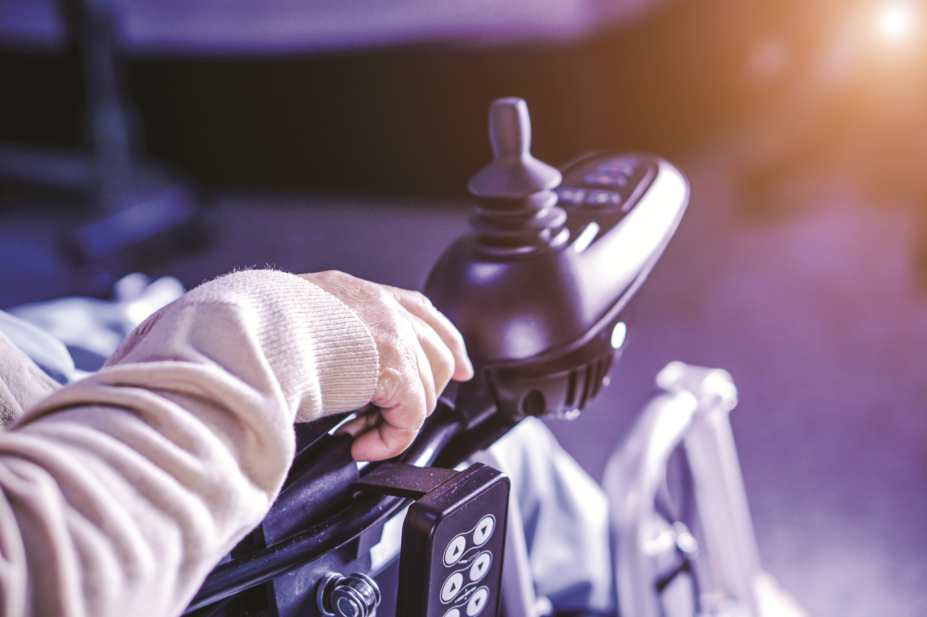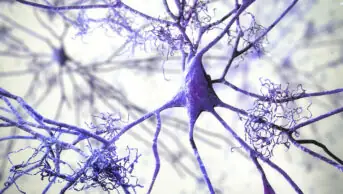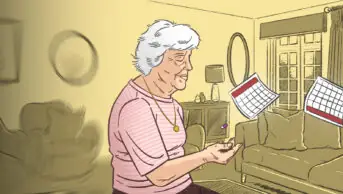
Shutterstock.com
Motor neurone disease (MND) is a neurodegenerative condition that affects the brain and spinal cord. It is thought that there are around 5,000 adults in the UK living with MND, the majority of whom are aged between 55 and 79 years[1]
. MND has unknown aetiology and is subdivided depending on the class of motor neurones affected (i.e. upper motor neurones [UMN] and lower motor neurones [LMN]) and the variety of symptoms present[2]
(see Table). As the disease progresses, the signs and symptoms become similar, irrespective of the initial MND type diagnosed. These symptoms include limb and torso muscle weakness, difficulty swallowing and speaking, and respiratory muscle weakness that leads to respiratory failure and death[3]
.
MND cannot be cured and ethical debates around assisted suicide, as the course and outcome of this disease can be extremely difficult for the patient and their relatives, have put a spotlight on the disease[2]
. However, symptom control is achievable to ensure optimum quality of life (QOL)[4]
. A multidisciplinary team (MDT) approach is paramount in achieving this and the involvement of palliative care specialists is recommended from initial diagnosis[2]
in order to offer a holistic management approach, where the needs of the patient and relatives are met throughout the trajectory of the disease.
As part of a MDT, pharmacists can advise on the administration of medicines prescribed for the control of symptoms associated with MND. This article describes the holistic management of the most common symptoms encountered in MND and provides examples of how this is applied locally in the UK.
| Amyotrophic lateral sclerosis (ALS) | Progressive bulbar palsy (PBP) | Progressive muscular atrophy (PMA) | Primary lateral sclerosis (PLS) | |
|---|---|---|---|---|
| Motor neurones affected | Upper motor neurones and lower motor neurones | Upper motor neurones and lower motor neurones | Lower motor neurones | Upper motor neurones |
| Common signs and symptoms |
|
|
|
|
| Percentage of patients with motor neurone disease (%) | 85 | 5 | 5–10 | 1 |
| Life expectancy from time of onset | 2–5 years | 6 months–3 years | 5 years or longer, but often progresses into ALS | 5–15 years |
| Sources: [2],[5],[6] | ||||
Common symptoms and their management
Problems with muscles and movement
Muscle weakness, muscle twitching, cramps and stiffness are all commonly experienced by people with MND.
Cramps
First-line treatment is quinine bisulphate 300mg tablets at night[3]
. Since no formal trials have studied the nature of cramps in MND or the effect of medicine on cramps in this disease[7]
, evidence is based on quinine bisulphate use in muscle cramps regardless of cause. A meta-analysis of 23 trials demonstrated low-quality evidence that quinine (most commonly used dose of 300mg/day) reduced the number and days of muscle cramps, while moderate-quality evidence demonstrated that it reduced the intensity of cramps[8]
. The Medicines and Healthcare products Regulatory Agency advises that quinine should only be used when cramps are painful and persistent, and that use is periodically reviewed for side effects (e.g. abdominal pain and hearing impairment)[9]
.
If quinine is ineffective or contraindicated, second-line treatment is baclofen 5mg twice or three times per day[3]
. If baclofen is not effective, not tolerated or contraindicated, consider tizanidine, dantrolene or gabapentin[3]
.
Stiffness
Baclofen, tizanidine, dantrolene or gabapentin can be considered to treat muscle stiffness, spasticity or increased tone in people with MND[3]
.
Physical exercise, such as stretching, which is adapted to the patient’s ability, can also help reduce stiffness and discomfort. Exercises will not strengthen the patient’s muscles, but will help to keep them as active as possible[3]
.
Decreased mobility
Physiotherapists can recommend exercises that help the patient maintain their posture and flexibility at initial stages of the disease, as well as exercises that focus on breathing as the patient approaches end of life. Occupational therapists can assess patients for wheelchair use, arm and neck supports, rise and recliner chairs, commodes and other equipment to aid activities around the house[10],[11]
.
Difficulty in swallowing and weight loss
When prescribing medicines it is important to consider if the patient has dysphagia and is unable to swallow[12]
. Speech and language therapists (SALTs) will be able to provide advice on food and drink consistency, as well as appropriate body positioning during meals. Dietitians can help determine calorific intake and optimise nutritional supplements.
Surgically, a percutaneous endoscopic gastrostomy (PEG) is indicated when the patient is considered to be at high risk of aspiration, choking, malnutrition and dehydration[10]
. MND nutritional guidelines recommend PEG insertion once the patient experiences >10% weight loss and has a forced vital capacity (FVC) of >50% predicted for the patient’s age and height[13]
. A retrospective study of 150 dysphagic amyotrophic lateral sclerosis (ALS) patients demonstrated that PEG insertion increased overall survival by at least 6 months. A proportion of the patients studied who had successful PEG insertion had FVC <50% with short-term mortality (at one month) similar to that of patients with FVC >50%. They showed marginally higher medium-term mortality (at six months), but this was non-significant[14]
. In practice, a MDT approach is instrumental to assess and advise the patient on whether PEG insertion is appropriate and beneficial[11]
.
Chronic drooling
Also known as sialorrhoea, drooling occurs owing to poor handling of saliva and not necessarily owing to excess saliva production.
The anticholinergic treatment, hyoscine hydrobromide patch 1.5mg every 72 hours, as well as amitriptyline 10mg three times per day or atropine eye drops 0.5% or 1% two to four times per day sublingually, are recommended by national and European guidelines as first-line treatment options[3],[15]
.
For patients with cognitive impairment, glycopyrronium is an alternative[3]
as its poor lipophilicity prevents its passage through the blood–brain barrier, resulting in minimal medication-induced drowsiness[16]
.
If first-line treatment for sialorrhoea is not effective, not tolerated or contraindicated, the National Institute for Health and Care Excellence (NICE) recommends botulinum toxin A administration in a specialist setting[3]
. In a systematic review, 7 out of 12 studies reported a statistically significant reduction in drooling after treatment with botulinum toxin A or B; however, none of the trials were specifically related to MND patients. The neurotoxin, which is used as an unlicensed drug, is injected into the salivary glands[17]
.
Non-pharmacological management involves encouraging good oral hygiene, using suction methods as necessary and ensuring appropriate hydration.
Respiratory symptoms
MND affects involuntary respiratory muscles, resulting in shortness of breath on exertion and poor cough reflex, leading to increased risk of respiratory tract infections and carbon dioxide retention. Patients will experience difficulty in lying flat, night-time waking, morning headaches and daytime fatigue.
Physiotherapists and respiratory medical teams advise on positioning and breathing exercises to regularly assess spirometry[10]
, appropriately manage sialorrhoea and treat respiratory tract infections that may arise[3]
, as respiratory failure with bronchopneumonia is a major cause of death in patients with MND[18]
.
Non-invasive intermittent positive pressure ventilation via a nasal mask may be used initially at night only to help control night-time symptoms. A ‘just in case’ kit, including an opioid and benzodiazepine can be offered, particularly when assisted ventilation is withdrawn.
Evidence demonstrates the benefit of morphine in the treatment of dyspnoea for patients with cancer, COPD and heart failure; however, there are no studies evaluating its use in patients with MND[13]
. Based on palliative care practice, data are extrapolated to conditions such as MND, whereby opioids have resulted in the reduction of patients’ sensation of breathlessness. In opioid-naive cancer patients, 1–2.5mg of morphine immediate release 4-hourly pro re nata (PRN) is used, titrated to response. For non-malignant conditions, smaller doses and less frequent administration may be adequate[19]
.
In MND, parenteral options must be considered if the patient is unable to swallow[3],[13]
. In breathlessness associated with anxiety, 2–10mg diazepam daily with additional sublingual lorazepam PRN may be indicated. Likewise, the route of administration must be taken into account[3]
, with parenteral midazolam or levomepromazine being alternative options[19]
.
Invasive mechanical ventilation can prolong survival of patients with MND; however, there is no evidence showing improvement in QOL. It has high implications in terms of cost, carers and emotional strain[13]
and is, therefore, rarely used[10]
.
Effect on speech
SALTs can carry out a review of the patient’s speech and different forms of communication, while neuropsychologists can formally assess and support the patient as language capacity deteriorates[13]
. Communication aids, such as pen and paper, tablets and other speech-generating devices can perpetuate the patient’s ability to communicate for as long as possible. Dexterity will require continual assessment as patients become unable to write and need further technological input, such as computerised speech synthesisers.
Other symptoms
Patients with MND may also experience:
- Emotional lability;
- Cognitive and behavioural changes;
- Frontotemporal dementia;
- Anxiety;
- Depression.
Patients with anxiety and depression may benefit from interaction with support groups, online forums and counselling, as well as from pharmacological management as per guidelines for non-MND patients[3]
.
As the patient approaches the end of their life, the palliative care team must consider the proper timing to discuss this event with them and their family. The patient’s cognition and mental capacity should be taken into account and psychological support sought, if beneficial[3]
.
Slowing progression
Riluzole is currently the only drug licensed for the treatment of individuals with ALS and has been shown to slow down the progression of the disease[15]
. It should be initiated by a neurological specialist with expertise in the management of MND[20]
.
Box 1 provides an example of how MND is managed by a MDT in Dorset, while Box 2 provides a patient perspective on the condition.
Box 1: Multidisciplinary team management of motor neurone disease in Dorset, UK
Diagnosis
A patient with confirmed or likely motor neurone disease (MND) is promptly referred to a neurologist specialised in MND. Upon confirmation of diagnosis, the joint MND and palliative care multidisciplinary team (MDT) takes a proactive approach to management with early and advanced care planning whereby patient cognition, respiratory function, nutrition requirements and palliative care needs are continually considered and assessed[21]
.
A single healthcare professional expert in MND will contact the patient within two weeks of initial diagnosis to arrange a follow-up appointment[21]
, where the nomination of a ‘single point-of-contact’ or keyworker is arranged to facilitate patient support[3]
.
The following is covered during the appointment:
- Advice on symptom management;
- Discussion about patient’s, their family’s and carers’ concerns;
- Support contact numbers;
- What action should be taken during an emergency.
The National Institute for Health and Care Excellence (NICE) guideline on MND advises that this follow-up appointment occurs within four weeks of diagnosis[3]
, which is a target achieved within Dorset[22]
. The ideal interval between subsequent appointments is not stated in national guidelines. In Dorset, the reviews are timed according to patient need and, therefore, adjusted on an individual basis with a maximum interval of three months for all patients[21]
.
Some patients may have no available care at home or are caring for others[3]
. Locally, the family support team, children’s support team and social services can provide help[21]
.
The patient’s wishes for treatments or interventions, ‘do not attempt resuscitation’ orders and lasting power of attorney[21]
are discussed with the keyworker and relevant members of the MDT[3]
.
Nutrition pathway
In Dorset, MND patients have access to a registered dietitian for nutritional assessment[23]
. Dietary advice is sought if >5% weight loss is noted, which is more cautious than the European guidance of >10% weight loss[13]
.
If a patient agrees to percutaneous endoscopic gastrostomy (PEG) tube insertion, their forced vital capacity (FVC) is assessed. If their FVC is >60%, the patient is referred directly to the gastroenterology team, but if it is <60%, then respiratory specialists are involved[23]
. This practice was discussed with the local neurologist expert in MND who stated that patients with <60% FVC can go on to have a PEG insertion, but are monitored more carefully to minimise any undue harm.
Sialorrhoea pathway
In Dorset, anticholinergics are first-line therapy, as per the NICE guidance[3],[24]
. Many patients present with cognitive impairment, resulting in glycopyrronium bromide 1mg/mL orally/PEG at a dose of 1–2mg twice daily to be used and titrated according to response[22]
. This dose is based on evidence from a trial specifically studying patients with amyotrophic lateral sclerosis[25]
.
Botulinum toxin A is not funded by the clinical commissioning group and, therefore, cannot be offered in Dorset[24]
. In thick tenacious secretions, carbocisteine 1.5–2.25g daily in divided doses is tried, as per BNF recommendations[26]
.
Respiratory pathway
Baseline spirometry and symptoms are obtained, physiotherapy referral is made and a ‘just in case’ kit is offered if appropriate[3]
. Symptoms of dyspnoea, orthopnoea, early morning headaches and daytime fatigue are continually assessed and non-invasive positive pressure ventilation is offered as symptoms worsen[27]
.
If the patient requests invasive ventilation, the relevant commissioning body is contacted for NHS Continuing Healthcare Panel approval. A ceiling of care must be established with the patient, including when ventilation will be withdrawn[27]
. In Dorset, this route is rarely followed[22]
.
End of life
The Dorset pathway identifies symptoms, such as recurrent infections and increasing shortness of breath, as an indication that the palliative care team need to have sensitive end-of-life discussions with the patient, using communication aids if needed, at the proper timing[28]
. An individualised end-of-life plan is communicated to all MDT or out-of-hours carers. When the patient dies, bereavement support is provided to the family and carers by the palliative care team[28]
, as per the NICE guideline[3]
.
Box 2: Patient perspective — Jack, a 56-year-old man living with motor neurone disease
January 2017
Jack* was diagnosed with amyotrophic lateral sclerosis (ALS) — the most common type of MND. Initial signs of disease presented as occasional stumbling while out walking the dog (limb muscle weakness) and speech impediment (bulbar muscle weakness).
Upon diagnosis, Jack’s wife, Clarissa*, remembers reading up on the disease and learning that life expectancy was a matter of a few years. She states: “I didn’t understand what I was reading. ALS had come out of nowhere, but it changed so much of our lives.”
September 2017
Jack lost the ability to eat orally. He and his wife had already had discussions with the local palliative care team and were aware that this would happen during the progression of the disease. “We were prepared and we knew that a [percutaneous endoscopic gastrostomy] tube was the necessary and right thing to do,” says Jack.
October 2017
Walking became more difficult for Jack, who had been using a cane up until this point. Through one of his regular therapy assessments with the physiotherapist and occupational therapist, Jack was able to obtain a wheelchair. He was encouraged to still undertake ongoing daily exercises to maintain as much muscle strength as possible for as long as possible.
November 2017
Further bulbar muscle weakness became apparent as Jack lost the ability to speak and salivation became more of a problem.
To aid communication, Jack says ‘yes’ by lifting his eyebrows and ‘no’ by closing his eyes. “Tools and techniques become very important for simple daily tasks,” says Jack through his voice synchroniser. “The patch (hyoscine hydrobromide) he was prescribed has helped to control excess saliva and we have a little suction machine thing as well,” explains his wife.
December 2017
Jack lost all ability to walk. Strength in both legs and arms failed first, followed by torso muscle weakness. “I remember when he could no longer type with his hands, he used his nose. Now that he cannot use his nose, he types with his eyes — amazing technology,” affirms Clarissa.
Present
Since diagnosis, Clarissa has been Jack’s full-time carer. The local palliative care nurse specialising in MND, along with other specialists in the multidisciplinary team, provide ongoing support and help the couple adapt to Jack’s deterioration. Both Jack and Clarissa appreciate the expertise and care provided by the healthcare team, and have good relationships with their GP and local pharmacist who they go to for advice on medicine’s administration.
“I appreciate the good things, the small daily senses and experiences I used to take for granted. I think about death daily, but I don’t feel like I’m dying. For now, there is a life force that just won’t give up,” declares Jack.
*All names have been changed for confidentiality.
Future perspective
Further research is necessary to elucidate the cause of MND, to develop and improve current treatment strategies, and to slow disease progression. Current NICE guidance recommends further research into the ALS Prognostic Index and whether this is an accurate predictor of survival in people with MND, as well as how to manage sialorrhoea[3]
.
References
[1] Motor Neurone Disease Association. Motor neurone disease. 2016. Available at: https://www.mndassociation.org/wp-content/uploads/living-with-mnd-guide-01-motor-neurone-disease.pdf (accessed March 2019)
[2] Talbot K. Motor neurone disease. Postgrad Med J 2002;78:513–519. doi: 10.1136/pmj.78.923.513
[3] National Institute for Health and Care Excellence. Motor neurone disease: assessment and management. NICE guideline [NG42]. 2016. Available at: https://www.nice.org.uk/guidance/ng42 (accessed March 2019)
[4] Oliver D. Euthanasia debate. Death from motor neurone disease can be peaceful. BMJ 1995;310(6992):1466–1467. PMID: 7542111
[5] Motor Neurone Disease Association. What is MND? 2018. Available at: https://www.mndassociation.org/about-mnd/where-do-i-start/what-is-mnd/ (accessed March 2019)
[6] National Institute of Neurological Disorders and Stroke. Motor neurone diseases fact sheet. 2018. Available at: https://www.ninds.nih.gov/Disorders/Patient-Caregiver-Education/Fact-Sheets/Motor-Neuron-Diseases-Fact-Sheet (accessed March 2019)
[7] Baldinger R, Katzberg HD & Weber M. Treatment for cramps in amyotrophic lateral sclerosis/motor neurone disease. Cochrane Database Syst Rev 2012;4:CD004157. doi: 10.1002/14651858.CD004157.pub2
[8] El-Tawil S, Al Musa T, Valli H et al. Quinine for muscle cramps. Cochrane Database Syst Rev 2015;4:CD005044. doi: 10.1002/14651858.CD005044.pub3
[9] Medicines and Healthcare products Regulatory Agency. Quinine: not to be used routinely for nocturnal leg cramps. 2014. Available at: https://www.gov.uk/drug-safety-update/quinine-not-to-be-used-routinely-for-nocturnal-leg-cramps (accessed March 2019)
[10] Evans J & Shaw PJ. Motor neurone disease: management of the condition. Pharm J 2001;267:714–717.
[11] UK Medicines Information. NICE Bites: Motor Neurone Disease. 2016. Available at: https://www.sps.nhs.uk/wp-content/uploads/2016/07/NICEBites-Apr-2016-No-86-Motor-neurone-disease.pdf (accessed March 2019)
[12] Barnett N & Parmar P. How to tailor medication formulations for patients with dysphagia. Pharm J 2016;297(7892):106–108. doi: 10.1211/PJ.2016.20201498
[13] Andersen PM, Borasio GD, Dengler R et al. Good practice in the management of amyotrophic lateral sclerosis: clinical guidelines. An evidence-based review with good practice points. EALSC working group. Amyotroph Lateral Scler 2007;8(4):195–213. doi: 10.1080/17482960701262376
[14] Spataro R, Ficano L, Piccoli F & La Bella V. Percutaneous endoscopic gastrostomy in amyotrophic lateral sclerosis: effect on survival. J Neurol Sci 2011;304(1–2):44–48. doi: 10.1016/j.jns.2011.02.016
[15] Andersen PM, Abrahams S, Borasio GD et al. EFNS guidelines on the Clinical Management of Amyotrophic Lateral Sclerosis (MALS) — revised report of an EFNS task force. Eur J Neurol 2012;19(3):360–375. doi: 10.1111/j.1468-1331.2011.03501.x
[16] EMC. Glycopyrronium Bromide 1mg/5mL oral solution. 2018. Available at: https://www.medicines.org.uk/emc/product/7344/smpc (accessed March 2019)
[17] Squires N, Humberstone M, Wills A & Arthur A. The use of botulinum toxin injections to manage drooling in amyotrophic lateral sclerosis/motor neurone disease: a systematic review. Dysphagia 2014;29(4):500–508. doi: 10.1007/s00455-014-9535-8
[18] Evans J & Shaw PJ. Motor neurone disease: clinical features and pathogenesis. Pharm J 2001;267:681–684.
[19] NHS Health Education England. The Wessex Palliative Care Handbook: a good practice guide. 2014. Available at: https://www.hee.nhs.uk/sites/default/files/documents/Wessex%20palliative%20care%20handbook.pdf (accessed March 2019)
[20] National Institute for Health and Care Excellence. Guidance on the use of riluzole (Rilutek) for the treatment of motor neurone disease. Technology appraisal guidance [TA20]. 2001. Available at: https://www.nice.org.uk/guidance/ta20 (accessed March 2019)
[21] Motor Neurone Disease Association. Care pathway for people living with motor neurone disease in Dorset. 2018. Available at: https://www.mndassociation.org/wp-content/uploads/Care-Pathway-for-People-living-with-MND-in-Dorset-FEB-18.pdf (accessed March 2019)
[22] Motor Neurone Disease Association. Care pathways and clinical guidelines. 2018. Available at: https://www.mndassociation.org/forprofessionals/mndmanagement/best-practice-guidelines-and-pathways/care-pathway-and-clinical-guideline-examples/# (accessed March 2019)
[23] Motor Neurone Disease Association. Nutrition care pathway for people living with motor neurone disease in Dorset. 2018. Available at: https://www.mndassociation.org/wp-content/uploads/Nutrition-care-pathway-for-people-living-with-MND-in-Dorset-April-18.pdf (accessed March 2019)
[24] Dorset formulary. Available at: http://www.dorsetformulary.nhs.uk/searchresults.asp?SearchVar=Botulinum%20Toxin%20Type%20A (accessed March 2019)
[25] Banfi P, Ticozzi N, Lax A et al. A review of options for treating sialorrhea in amyotrophic lateral sclerosis. Resp Care 2015;60(3):446–454. doi: 10.4187/respcare.02856
[26] British National Formulary. Carbocisteine. Available at: https://bnf.nice.org.uk/drug/carbocisteine.html (accessed March 2019)
[27] Motor Neurone Disease Association. Respiratory care pathway for people living with motor neurone disease in Dorset — non-invasive ventilation. 2018. Available at: https://www.mndassociation.org/wp-content/uploads/Respiratory-Care-Pathway-NIV-Dorset-June-2018.pdf (accessed March 2019)
[28] Motor Neurone Disease Association. A professional’s guide to end of life care in motor neurone disease (MND). 2016. Available at: https://www.mndassociation.org/wp-content/uploads/px012-a-professional-guide-to-end-of-life-care-in-mnd-v1-0-jan16-web.pdf (accessed March 2019)



